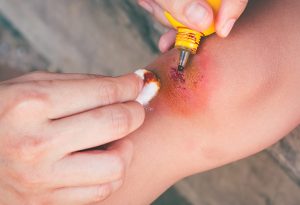In this Article
Dogs are considered man’s best friend and it is natural to assume that your best friend will not harm you! But it is important to remember that dogs too can feel threatened or become over excited and knowingly or unknowingly lash out at you or your child in the one way they know best – biting. It is also a fact that children are more vulnerable to dog bites than adults. They are also the most likely to require inpatient hospital stay or reconstructive surgery in the aftermath of such injuries.
Why Do Dogs Bite Children?
You cannot predict when or why a dog is likely to bite your child. There are some reasons why a dog might bite. They are pack animals, and it is these instincts that determine most of their behaviour. A large number of dog bite incidents involve children under the age of five and dogs who are familiar with them. The following are some reasons why this happens:
- Compared to very young children, some dogs can appear big in terms of size. This can give them a feeling of superiority that can then appear in the form of protectiveness of an object, territory, or a person.
- Small children such as those aged under five, might not know their boundaries when playing with the family dog or a neighbour’s dog. The child might pull the dog’s tail or fur playfully but this can provoke the animal to bite.
- When children get too close to a dog suddenly and startle it, the animal might react by attacking.
- A sick or injured dog might bite.
- When a dog perceives a running child as prey, it can lead to biting.
First Aid for Dog Bites in Kids
If there are no visible marks on the skin such as tearing or punctures, then usually it is not necessary to see a doctor. But, after administering first aid, it is best to seek medical opinion and err on the side of caution. Here is what to do if the family dog bites child:
- Stem the bleeding by using a clean towel to apply pressure to the wound. You can also elevate the injured limb.
- Use soap and water to clean the affected area and then hold it under running water for a while.
- Dab dry, apply an antibiotic ointment and use a fresh bandage on the wound.

Types of Damage Caused By a Dog Attack
Besides the physical pain that your child is likely to endure as a result of being bitten by a dog, there is also bound to be a certain amount of emotional trauma to deal with as well.
- Physical
Dog bites can be categorized from minor to severe. While minor ones only require a visit to the doctor and basic first aid, severe injuries might even require surgery. This is because severe injuries usually are the ones that occur on the head, neck, and face where the nerves and bones might easily be affected. Reconstructive operations may be required to repair this type of physical damage.
- Emotional
The mental trauma that your child experiences as a result of a dog bite is likely to last a lifetime. This might also change your child’s perception of dogs and even pets forever. Getting your child evaluated for emotional trauma and seeking counselling can help them get through this.

Treatment
After administering first aid, it is best to seek out a medical opinion irrespective of the severity of the bite to avoid any further complications. The doctor might give your child a tetanus injection and also prescribe antibiotics to prevent or control infection. A plastic surgeon will be called in if the injuries need reconstructive surgery, especially when it is the face or neck.
Risks Associated With Rabies
If it is suspected that the dog has rabies, your child will need to be immunized within two days of being attacked. The dog can be quarantined and observed for ten days to determine the presence of rabies. If the animal is found to be free of rabies, then the immunization can be discontinued.
Prevention
Here are some simple tips that can help you keep your child safe from dog bites and attacks.
- When choosing a pet dog, go for a breed that is known for its gentle nature.
- Never leave your child unsupervised around a dog; even if it is the family pet that has been with you for long.
- Avoid displays of affection that involve hugging and kissing or something similar that can put your face too close to the dog.
- Do not approach a dog feeding her puppies.
- Teach your child to deal with aggressive dogs. Tell them to stand still and look down if the dog seems unfriendly.
- Make sure your children know not to tease dogs by snatching their toys or treats.
- Dogs must not be disturbed when they are eating or sleeping.
- Instruct your children to avoid unknown dogs and not to try and pet them.
- Teach your family dog that good things happen when children are nearby.
- Provide your dog with a child-free zone as a space to retreat to such as a kennel or a partitioned enclosure.
- Encourage gentle behaviour towards dogs in your child.
- If the dog is with its owner, always seek the owner’s permission before approaching the dog.
- Tell kids that the dog will play with them only as long as it wants to and when it walks away, it means he has had enough for the time being.
- Be sure to keep an eye on any new strays that wander into your neighbourhood and report them to the appropriate authorities.
If the skin is not punctured or disrupted, then basic first aid is likely to suffice. But be sure to call your doctor if you notice any of the following:
- If you do not know the dog that bit your child. In this case, a rabies shot might be required.
- The bite wound is quite deep or it is on your child’s face.
- The bleeding doesn’t stop even after ten minutes of applying direct pressure.
- If your child’s tetanus shot is overdue
- When you notice signs of infection such as redness, swelling, pus, or the area being warm to touch.
Do not panic if your child is the victim of a dog bite. Administer first aid and then take your child to the nearest hospital or your doctor’s office for further evaluation.
This information is just a guide and not a substitute for medical advice from a qualified professional.









